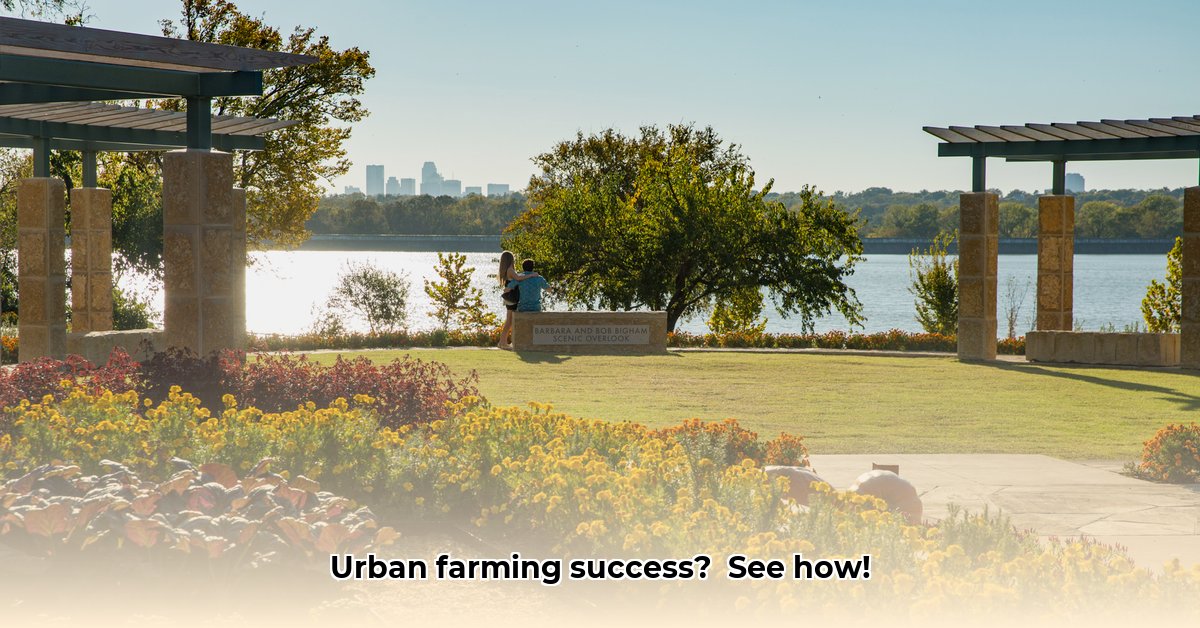Nestled within the vibrant Dallas Arboretum, A Tasteful Place stands as a compelling example of sustainable urban farming. More than just a garden, it serves as a living laboratory, connecting the community with locally grown produce and innovative farming practices. But how truly successful is this model, and what lessons can it offer to other urban centers?
The Design and Implementation of Sustainable Agriculture
A Tasteful Place harmoniously blends aesthetic appeal with practical functionality, drawing inspiration from the “potager” style – a French ornamental kitchen garden. The diverse elements, including a fruit orchard, herb gardens, and a serene lagoon, create an immersive experience for visitors. Educational events, a state-of-the-art teaching kitchen, and a versatile pavilion further foster community learning and appreciation for sustainable food systems. The Dallas Arboretum has effectively integrated these components to create an engaging and memorable destination.
Environmental Impact and Economic Sustainability
While the Dallas Arboretum actively promotes water conservation, a comprehensive, data-driven analysis is necessary to fully assess the garden’s overall environmental footprint. This includes a detailed evaluation of energy consumption, particularly during the off-season when greenhouse operations may require significant power input. Concrete financial metrics, such as return on investment (ROI), revenue generation, and detailed operating costs, are crucial for understanding the project’s long-term financial viability. Such data is essential for informed future planning, potential expansion, and attracting further investment.
Community Engagement and Food Security Initiatives
A Tasteful Place actively cultivates educational outreach programs through strategic partnerships with local schools, community organizations, and culinary institutions, promoting a deeper understanding of sustainable food systems and healthy eating habits. Strengthening collaborations with local restaurants, farmers markets, and food banks could significantly amplify its impact on local food security. Exploring innovative volunteer programs, community-supported agriculture (CSA) initiatives, or collaborative partnerships with local chefs could further enhance community engagement and promote the consumption of locally sourced produce.
Scalability and Year-Round Production Strategies
A critical question is scalability: can the A Tasteful Place model be successfully replicated in other urban environments with varying climates, demographics, and resource availability? The design requires careful adaptation to suit diverse contexts, considering factors such as available space, average sunlight exposure, local climate conditions, and specific community needs. The energy efficiency and environmental impact of the greenhouse’s year-round food production capabilities require thorough evaluation, exploring options for renewable energy integration and minimizing waste.
Collaboration and Future Research Directions
A comprehensive analysis of various key metrics, including visitor numbers, economic impact on the local economy, water usage efficiency, and overall carbon footprint, is paramount. This analysis requires close collaboration between the Arboretum, community organizations, academic researchers, and funding bodies. A robust risk assessment, addressing potential challenges related to funding gaps, environmental concerns, community engagement, and operational issues, is essential for ensuring long-term sustainability and resilience. What specific, actionable steps can be taken to proactively mitigate potential environmental concerns and optimize resource utilization?
Risk Assessment Matrix
| Risk Factor | Likelihood | Impact | Mitigation Strategy |
|---|---|---|---|
| Funding Shortfalls | Medium | High | Diversify funding sources through grants, sponsorships, and individual donations; develop a comprehensive fundraising strategy; secure long-term funding commitments with key stakeholders. |
| Negative Environmental Impact | Low | Medium | Conduct regular environmental audits; implement sustainable resource management practices; optimize water and energy usage; explore renewable energy solutions; minimize waste generation. |
| Community Disengagement | Low | Medium | Maintain continuous community outreach through events, workshops, and online platforms; implement flexible programming that caters to diverse interests and needs; solicit regular feedback. |
| Operational Challenges | Medium | Medium | Develop standardized operating procedures; provide comprehensive staff training and ongoing support; implement a preventive maintenance program for all equipment and infrastructure. |
| Scalability Limitations | High | High | Conduct thorough site assessments to evaluate suitability; develop adaptable project designs that can be modified based on specific site constraints; explore modular construction techniques. |
A Blueprint for Sustainable Urban Farming Initiatives
A Tasteful Place serves as a powerful demonstration of the potential of sustainable urban agriculture, seamlessly combining aesthetic beauty, environmental responsibility, and strong community engagement. However, further investigation and rigorous data collection are essential for fully understanding its scalability, long-term environmental effects, and socioeconomic impact. What key insights and best practices can be gleaned from the A Tasteful Place model to inform future urban farming initiatives and promote more sustainable and resilient urban food systems?
How to Replicate the A Tasteful Place Sustainable Urban Farm Model
Key Takeaways:
- Urban farming initiatives offer significant benefits, including enhanced food access for underserved communities, reduced transportation-related carbon emissions, and the fostering of stronger community engagement and social cohesion.
- Economic viability of urban farms can vary significantly; while some thrive and become self-sustaining, others struggle with high initial investment costs and ongoing operational expenses.
- Successful replication of the A Tasteful Place model requires addressing a complex interplay of factors, including navigating regulatory hurdles, adapting to local land-use policies, and ensuring strong community acceptance and participation.
- Technological advancements hold significant potential for optimizing urban farming practices, but require careful evaluation to ensure cost-effectiveness, ease of implementation, and minimal environmental impact.
Understanding the A Tasteful Place Model: Key Elements
To successfully replicate the A Tasteful Place sustainable urban farm model, a thorough analysis of its key elements, operational strategies, and community engagement techniques is essential. What specific design features, agricultural practices, and educational programs contribute most to its success, and how can these be adapted for implementation in different contexts? What unexpected challenges were encountered during its development, and how can those lessons be applied elsewhere to improve overall efficiency and yield?
Essential Components of a Successful Model
Several critical factors contribute to the overall success and sustainability of the urban farming model exemplified by A Tasteful Place:
- Community Engagement: Cultivating a strong sense of shared ownership and collective responsibility through the establishment of vibrant community markets, interactive educational programs, volunteer opportunities, and collaborative decision-making processes.
- Strategic Location and Design: Optimizing space utilization through innovative vertical farming techniques, rooftop gardens, or the integration of green infrastructure, while maintaining structural integrity and minimizing environmental impact.
- Technological Integration: Enhancing operational efficiency and resource management through the strategic implementation of smart technologies, such as IoT sensors for real-time monitoring of environmental conditions, automated irrigation systems, and data analytics platforms for yield optimization.
- Economic Viability: Developing a clear and sustainable business model that considers all aspects of the operation, including production costs, pricing strategies, marketing initiatives, diversified revenue streams, and potential funding sources from grants, sponsorships, or private investment.
- Regulatory Compliance: Proactively engaging with local authorities and government agencies to navigate complex zoning laws, building codes, food safety regulations, and environmental compliance requirements, ensuring full adherence to all applicable legal frameworks.
Replicating the Model: A Step-by-Step Approach
- Conduct Thorough Site Assessment: Conduct a comprehensive analysis of the available land or building space, considering factors such as sunlight exposure, water access, soil quality (if applicable), structural capacity, and proximity to target communities.
- Develop a Comprehensive Business Plan: Develop a detailed business plan that outlines production goals, target markets, competitive analysis, pricing strategies, marketing plans, financial projections (including startup costs, operating expenses, and revenue forecasts), and funding requests.
- Engage with the Community: Establish strong relationships with local residents, community organizations, businesses, government agencies, and other relevant stakeholders to build support, gather input, and foster a sense of shared ownership.
- Select Appropriate Technologies: Evaluate and select technologies that are aligned with the project’s scale, budget, production goals, and environmental impact considerations, considering factors such as energy efficiency, water conservation, and waste reduction.
- Ensure Regulatory Compliance: Work closely with local authorities to obtain all necessary permits and licenses, ensuring compliance with zoning regulations, building codes, food safety standards, and environmental protection requirements.
- Implement Robust Monitoring and Evaluation: Establish a comprehensive monitoring and evaluation system to track key performance indicators (KPIs) such as crop yield, energy consumption, water usage, waste generation, economic performance, community engagement metrics, and overall environmental impact.
Challenges and Considerations
While replicating the A Tasteful Place model may appear straightforward, several potential challenges and considerations must be addressed proactively:
| Challenge | Mitigation Strategies |
|---|---|
| High Initial Investment Costs | Seek diverse funding sources, including grants, sponsorships, private investment, and crowdfunding; explore modular designs to reduce upfront construction costs; leverage in-kind donations of materials or services. |
| Regulatory Hurdles | Proactively engage with local authorities early in the planning process; conduct thorough research on all applicable regulations; prepare detailed permit applications; seek guidance from experienced legal counsel. |
| Community Acceptance | Conduct transparent communication and outreach efforts to educate residents about the benefits of the project; actively involve local residents in the planning and decision-making processes; address any concerns or objections proactively. |
| Scalability | Adopt modular designs that can be easily expanded or adapted to different site conditions; establish partnerships with other organizations or businesses to share resources and expertise; leverage technological innovation to improve efficiency. |
[This analysis requires further quantitative data for a complete and accurate picture. More research is needed.]
- Unlock Your Potential with Adult Vocal Lessons at Any Age - January 8, 2026
- Adult Voice Lessons Transform Your Singing and Build Confidence - January 7, 2026
- Vocal Performance Artistry Requires Unmatched Control and Emotional Depth - January 6, 2026










